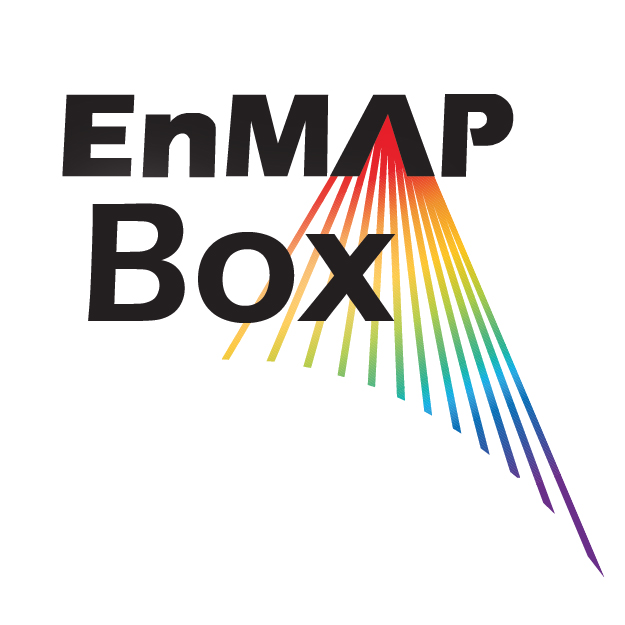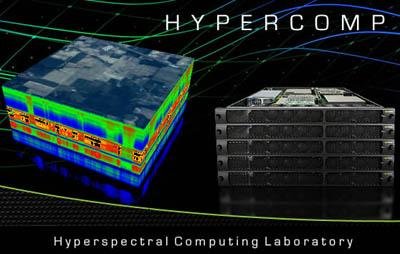Hyperspectral Imagery
ENMAP-BOX |
|
Platform: Platform-independent
Software / Code: IDL
Requirements: IDL 8.4 runtime environment
Features:
- easy-to-use GUI, with drop-down menus, expandable tree-based file explorer and drag-and-drop capabilities
- visualization and processing of hyperspectral image data and field/laboratory spectra
- import and export from and to different data formats
- in-built applications aimed at the processing of hyperspectral data, such as Support Vector Machines and Random Forests for classification or regression of image data
- externally developed applications for EnMAP data processing, e.g. Partial Least Squares Regression or the calculation of different agricultural spectral indices. See Applications for an overview of all applications.
- a rich application programming interface (hubAPI) that allows to develop new EnMAP-Box applications easily
Webpage: http://www.enmap.org/?q=enmapbox
Reference:
- van der Linden, S.; Rabe, A.; Held, M.; Jakimow, B.; Leitão, P.J.; Okujeni, A.; Schwieder, M.; Suess, S.; Hostert, P. The EnMAP-Box—A Toolbox and Application Programming Interface for EnMAP Data Processing. Remote Sens. 2015, 7, 11249-11266
- EnMAP-Box Documentation: https://bitbucket.org/enmapbox/enmap-box/wiki/Home
Last modified: 2015
Comments:
HIIHAT
Publisher: NASA, JPL
Platform:
Software / Code: IDL/ENVI
Requirements: IDL/ENVI (GUI-based plug-in to the ENVI software package)
Features: The Hyperspectral Image Interpretation and Holistic Analysis Tools (HiiHAT) is an intelligent assistant to help analysts efficiently browse, summarize, and search hyperspectral images. The software is available as a plugin to the IDL/ENVI environment. The algorithms we have developed are designed for the special challenges of planetary science datasets:
- High noise levels Many of the most interesting planetary science questions involve spectral features at the limits of detectability. We emphasize robust strategies capable of detecting subtle spectral features with high levels of noise.
- Uncertain constituents Unlike terrestrial remote sensing, we have very few if any samples from the surface. We address this with "unsupervised" analysis that looks for patterns in the observed data itself.
- Fast turnaround time Tactical observation planning may require fast decisions, favoring automation where appropriate.
The software toolkit includes automatic procedures to search images for key features and draft analyses for operators. More in-depth studies can benefit from interactive analysis procedures.
Webpage: https://github.com/dsmbgu8/HiiHAT
Last modified: 2013
Comments: Free, non-commercial research licenses via hiihat-licensing@jpl.nasa.gov
HSDAR
Publisher:
Platform:
Software / Code: R
Requirements: R
Features: The hyperspectral data analysis in R (hsdar) package contains classes and functions to manage, analyse and simulate hyperspectral data. These might be either spectrometer measurements or hyperspectral images through the interface of rgdal. Supported methods to analyse vegetation spectra are the calculation of red edge parameters (rededge), vegetation indices (vegindex) as well as ndvi-like narrow band indices (nri). hsdar further enables to perform spectral unmixing of spectra (unmix) by use of endmember spectra. hsdar has implemented the models PROSAIL 5B and PROSPECT 5 to simulate spectra of canopy and plants.
Webpage: http://sourceforge.net/projects/hsdar/
Reference:
Last modified: 2015
Comments:
HYPERCUBE
Publisher: US Army Geospatial Center
Platform: Windows, Macintosh
Software / Code:
Requirements:
Features: HyperCube is a Macintosh and Windows application program specifically directed to the analysis and display of multi and hyperspectral imagery. This includes the static and dynamic display of the image cube and the generation of spectral classifications using both imagery and spectral libraries. In addition, HyperCube contains functions to filter, warp, mosaic, reformat, calibrate, combine, photogrammetrically project, stereo compile and to perform arithmetic on imagery and data.
Reference: HyperCube Pictorial User’s Guide
Last modified: 2015
Comments:
HyperMixTool |
|
Publisher: Research Group "Hyperspectral Computing" (HyperComp), University of Extremadura
Platform: Linux, Windows
Software / Code: C++
Requirements:
Features: HyperMix is an open source tool for remote sensed hyperspectral image unmixing. It includes several popular algorithms covering different steps of the hyperspectral unmixing chain.
Webpage: http://sourceforge.net/projects/hypermixtool/
Reference:
Last modified: 2015
Comments:
HyperSpy |
|
Publisher: HyperSpy development team
Platform: Multiplatform
Software / Code: Python
Requirements: Python
Features: HyperSpy is an open source Python library which provides tools to facilitate the interactive data analysis of multi-dimensional datasets that can be described as multi-dimensional arrays of a given signal (e.g. a 2D array of spectra a.k.a spectrum image). HyperSpy aims at making it easy and natural to apply analytical procedures that operate on an individual signal to multi-dimensional arrays, as well as providing easy access to analytical tools that exploit the multi-dimensionality of the dataset. Its modular structure makes it easy to add features to analyze different kinds of signals.
Webpage: http://hyperspy.org
Reference: http://dx.doi.org/10.5281/zenodo.28025
Last modified: 2015
Comments: Linked to the European network for electron microscopy (esteem2)
MATLAB HYPERSPECTRAL TOOLBOX
Publisher: Isaac Gerg
Platform: Windows
Software / Code: MATLAB
Requirements: MATLAB
Features: The open source Matlab Hyperspectral Toolbox is a matlab toolbox containing various hyperspectral exploitation algorithms. The toolbox (will) include(s) functions for:
- Target detection
- Material abundance map (MAM) generation
- Automated processing
- Change detection
- Visualization
- Reading / writing files (.rfl, .asd, ect)
Webpage: https://github.com/isaacgerg/matlabHyperspectralToolbox
Reference: Gerg, I. ”An Evaluation of Three Endmember Extraction Algorithms: ATGP, ICA-EEA, & VCA.” Second workshop on hyperspectral image and signal processing: evolution in remote sensing (WHISPERS). 14-16 June 2010.
Last modified: 2015
Comments:
MULTISPEC |
|
Publisher: Purdue Research Foundation (David Landgrebe and Larry Biehl, Purdue University and School of Electrical and Computer Engineering)
Platform: Windows, Macintosh
Software / Code:
Requirements:
Features: MultiSpec (© Purdue Research Foundation) is a processing system for interactively analyzing Earth observational multispectral image data such as that produced by the Landsat series of Earth satellites and hyperspectral image data from current and future airborne and spaceborne systems such as AVIRIS. The primary objective of MultiSpec is as an aid to export the results of our research into devising good methods for analyzing such hyperspectral image data.
Webpage: https://engineering.purdue.edu/~biehl/MultiSpec/
Reference:
- Landgrebe D. “Signal Theory Methods in Multispectral Remote Sensing”, 2003, ISBN 0-471-42028-X
- https://engineering.purdue.edu/~biehl/MultiSpec/documentation.html
Last modified: 2015
Comments: Web-enabled Version (small subset) of MultiSpec also available
PRISM
Publisher: : U.S. Geological Survey
Platform: Windows, Linux
Software / Code: IDL
Requirements: ENVI 4.8
Features: PRISM provides a framework to conduct spectroscopic analysis. This spectroscopic analysis allows the composition of the material to be identified and characterized. At its core, PRISM relies on comparisons of user-defined diagnostic absorption features in reflectance spectra of reference materials, collected in a spectral library, to the spectrum of an unknown material.
Webpage: http://pubs.usgs.gov/of/2011/1155/
Reference: Kokaly, R.F., 2011, PRISM: Processing routines in IDL for spectroscopic measurements (installation manual and user's guide, version 1.0): U.S. Geological Survey Open-File Report 2011-1155, 432 p., available at http://pubs.usgs.gov/of/2011/1155/.
Last modified: 2011
Comments:
Spectral Python
Publisher: Thomas Boggs
Platform: Platform-independent
Software / Code: Python
Requirements: Python
Features: Spectral Python (SPy) is a pure Python module for processing hyperspectral image data. It has functions for reading, displaying, manipulating, and classifying hyperspectral imagery. It can be used interactively from the Python command prompt or via Python scripts. SPy is free, open source software distributed under the GNU General Public License.
Webpage: http://www.spectralpython.net
Reference: Landgrebe, D. Multispectral data analysis: A signal theory perspective. School of Electr. Comput. Eng., Purdue Univ., West Lafayette, IN (1998).
Last modified: 2015
Comments:
Spectronon
Publisher: Resonon
Platform:
Software / Code: C++
Requirements:
Features: Spectronon contains many useful tools for hyperspectral data analysis, support user-written plugins, and provide numerous output options for reports and presentations. Spectronon is designed to help a user easily define and spectrally analyze specific regions of an image, as well as classify different signals throughout an entire image.
- Advanced image visualization tools
- Compatible with ENVI and standard formats (BIL, BIP, BSQ)
- Classification utilities: SAM, agricultural indices (NDVI, EVI), and more
- Unmixing utilities
- Supports user-defined plugins for custom analyses (uses Python programming language)
Webpage: https://resonon.com/Products/spectronon.html
Reference: http://docs.resonon.com/spectronon/pika_manual/html/
Last modified: 2015
Comments:


